side loading - 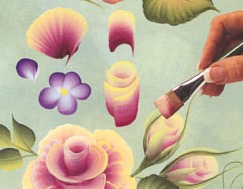 Also
called double loading; loading a brush with two colors
side by side. This is a technique
typical of tole and other kinds
of decorative painting.
In order to side load, use a paint of creamy consistency,
and drag one edge of the brush
through the lighter color as many times as needed to fill that
edge with color; then stroke the clean edge of the brush through
the darker color in the same manner. Once the brush is loaded
this way, blend the colors at the center of the brush by stroking
on the palette. Using this technique,
each brushstroke (application
of color) deposits a gradation
of the two blended colors.
Also
called double loading; loading a brush with two colors
side by side. This is a technique
typical of tole and other kinds
of decorative painting.
In order to side load, use a paint of creamy consistency,
and drag one edge of the brush
through the lighter color as many times as needed to fill that
edge with color; then stroke the clean edge of the brush through
the darker color in the same manner. Once the brush is loaded
this way, blend the colors at the center of the brush by stroking
on the palette. Using this technique,
each brushstroke (application
of color) deposits a gradation
of the two blended colors.
Related link:
Also see folk art.
sienna - Yellowish brown.
(pron. see-en'ə)
sign - Something that suggests the presence or existence of a fact, condition, or quality. An act or a gesture used to convey an idea, a desire, information, or a command. A conventional figure or device that stands for a word, a phrase, or an operation; a symbol. Sign language, or to communicate with a sign or by sign language; to signal. A structure or notice bearing a designation, direction, command, advertisement, or information, which may include lettering, symbols and other imagery; signage. To put one's signature on something, usually to mark it as one's own, or to approve.
Quote:
Also see allegory, attribute, definition, emblem, flag, graphic design, hallmark, heraldry, icon, numbered, personification, poster, seal, semiotics, and signage.
![]()
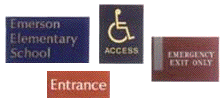
![]() signage - The design or use
of signs and symbols.
Signage may include billboards, posters,
placards, etc. It may refer to a number of signs thought of as
a group.
signage - The design or use
of signs and symbols.
Signage may include billboards, posters,
placards, etc. It may refer to a number of signs thought of as
a group.
More examples:
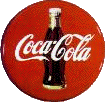
American, Coca Cola advertising
sign, 20th century, enamel on steel.
See circle and logo.

Around the world, McDonald's, an American fast-food restaurant
chain has used variations on this design marking its restaurants
since the 1960s. See arch.
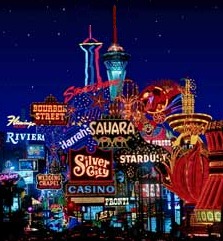
American, Las Vegas, Nevada. A vast number
of gambling casinos are located here. They compete with each
other for the largest, brightest, most active and expensive of
signs.
![]()
Jenny Holzer (American, 1950-), Truisms, 1983, computerized electronic
sign, 6 5/16 x 60 1/2 x 4 1/4 inches (16 x 153.7 x 10.8 cm),
Museum of Contemporary Art, Chicago, IL. "Truisms is a series
of 193 one-line statements which appear either as printed signs
or, as here, computer-generated graphics." See conceptual
art.

American, South Carolina, marquee sign outside of Lexington Middle School,
2003. (Has someone been messing around with the lettering here?)
Quotation about signage:
Other resources about signage:
Also see dingbat, glyph, graphic, graphic design, lettering, and logo.
signature, signed and unsigned
sikhara - In Hindu temples of Vishnu, the tower above the sanctum or shrine. The basic scheme of the Nagara cella comprises the pitha, or base, the prasada consisting of the garbagriha, a cuboidal inner sanctum, the mandovara, or wall which encloses the sanctum and the sikhara, a curvilinear solid of distinctive form that sits on top of the sanctum.
(pr. SHI:-ka-ra)
silenos - An older satyr.
Examples:
![]()
![]()
![]()
Etruscan, early 400s BCE,
Antefix, terra
cotta, 21 7/16 x 12 3/4 x 6 1/2 inches (54.6 x 32.5 x 16.5
cm), J. Paul Getty Museum, Malibu, CA. A silenos
and maenad dance in a Dionysiac revel
on this Etruscan
antefix.
![]()
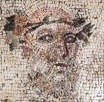
Greek, Head of Silenos, no date, mosaic.
silica, silicate, and silicon - A hard mineral substance found in various natural deposits. Silica ground into a granular form is a component of glass and ceramic bodies, cement and abrasives, and, further refined as silicon, in computer chips. Silica gel is a granular substance that has high moisture-absorbing and -emitting properties and is used as a moisture stabilizer in packing and storing humidity-sensitive objects.
Also see art conservation, clay, climate control, relative humidity, sand, and silicone rubber.
silicone rubber - A cold cure
molding polymer
compound which can withstand the heat of molten lead.
It is mixed from a rubber based solution and a catalyst.
Silicone rubber is used for small scale
casting. As a gel, silicone
is available in tubes from any hardware store. The transparent
kind is preferable because it permits the sculptor
to see air bubbles. A technique
some employ: first extrude
it under water, then apply it to the model
to make a flexible mold. If a thick mass
is needed, it is best
applied in coats. While silicone's
surface can cure rapidly,
if too thick a coat is made at once, the interior will not cure in a acceptable time. Many such products are hazardous.
Read labels well and follow all cautionary advice.
Also see release agent.
siltstone - A type of schist
which is dark gray and brown.![]()

![]()

![]()
silver leaf - Silver which has been beaten into as thin a sheet as it can be. It can be applied with the same techniques used for gold and other types of leaf. Because it oxidizes easily, unless it is coated with a durable varnish, it will eventually blacken.
silverpoint or silver point - A drawing point made of silver, which is used on a gesso coated surfaces, or the use of this technique, or the drawings made with it.
![]()

![]() simile - Refers to any figure of speech in which two essentially
unlike things are compared, often in a phrase introduced by like
or as. This literary term is derived from the word similar.
simile - Refers to any figure of speech in which two essentially
unlike things are compared, often in a phrase introduced by like
or as. This literary term is derived from the word similar.
(pr. SI-mə-lee)
Also see analogy, compare, likeness, metaphor, representation, simulacrum, simulation, synergy, and incongruity.
simplicity - Closely related to harmony — a principle of design — this term refers to the practice of using a limited number of similar elements to secure a more uniform appearance.
Quotes:
Also see elegance, ikebana, interdisciplinary, and monumental.
simulacrum - A representation, or an unreal or vague likeness. The plural is simulacra.
Also see analogy, appropriation, copy, counterfeit, ersatz, facsimile, fake, forgery, metaphor, mirror, paint-by-number, and replica, reproduction, simile, simulacrum, and simulation.
simulate, simulation - To simulate is to take on the appearance or form of, or to create a model of.
Example:
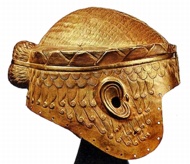
Mesopotamia, Royal Cemetery at Ur, Gold Helmet of King Meskalamdug, c. 2400 BCE, repoussé gold, height 22 cm, greatest diameter 26 cm. The decoration of the helmet simulates the king's crown, hair, and ears. Holes drilled along the lower edges enabled the attachment of an inner helmet. This is one of many Mesopotamian objects that have recently been lost or stolen from Iraq's museums, and have yet to be recovered. The Oriental Institute of the U of Chicago has posted a database of treasures that have been lost or stolen from Iraq. See arms and armor.
Also see airbrush, analogy, appropriation, copy, copyright, counterfeit, ersatz, facsimile, fake, forgery, grisaille, likeness, lorem ipsum, marbling, mirror, paint-by-number, panorama, patina, quadro riportato, representation, reproduction, simile, simulacrum, stimulate, synthesis, trompe l'oeil, virtual, virtual museum, and virtual reality.
Simultaneism - See Orphism.
sincere - Genuine, without hypocrisy.
More than one authority has repeated the story that "sincere" is derived from Latin sine cire, which means "without wax." According to this account, wax was often applied to rough surfaces, cracks, and other flaws in marble sculptures or pottery in order to conceal shabby craftsmanship or other defects, perhaps deceiving the viewer that the object was of higher quality; and if a marble or pot had no concealed flaws it was guaranteed to be sine cera — without wax. There is significant evidence that this is not actually how we have come to have the English word "sincere" however. The Oxford English Dictionary disavows this etymology, asserting, “There is no probability in the old explanation from sine cera ‘without wax.’” The OED says sincere came from the Latin “sincerus, clean, pure, sound.” Nevertheless, because the "folk" version is so popular and poignant, it bears repeating.
singerie - A scene in which monkeys are dressed in human clothes, and engaged in human activities. The French word for this is singe. There are precedents for this type of anthropomorphism in medieval manuscripts, and perhaps as far back as antiquity. Use of this term is usually reserved for a type of decorative painting associated with French Rococo. Jean Berain (French) and Claude Audran (French) originated the singerie as a genre at the beginning of the 18th century. Watteau also painted singeries.
(pr. SAH-jə-ree)
Examples:

Jean-Baptiste Siméon Chardin (French, 1699-1779), The Old Monkey (Le singe antiquaire), c. 1726, oil on canvas, 81 x 64 cm, Louvre.

Jean-Baptiste Siméon Chardin, The Painting Monkey (Le singe peintre), c. 1739-40, oil on canvas, 81 x 64 cm, Louvre.
Sir Edwin Landseer (English, 1802-1873),
The Traveled Monkey, 1827, oil
on wood panel,
width 56 cm, Guildhall Library
and Guildhall Art Gallery, London. The narrative is taken from the book Fables
by English author John Gay.

Alexandre-Gabriel Decamps (French, 1803-1860),
The Experts, 1837, oil
on canvas, 18 1/4 x 25 1/4
inches (46.4 x 64.1 cm), Metropolitan Museum of Art, NY.
Also see bestiary, chinoiserie, and zoomorphic.
sinking - The shaping of a malleable metal such as silver or gold by hammering it into a depression. Sinking is generally done to a sheet of metal.
Also see boss, declivity, emboss, raising, repoussé, and wrought iron.
sinopia or sinopie - A redish-brown earth color. Also, the cartoon or underpainting for a fresco.
sinter, sintering - To heat a mass of fine particles of ceramic, metal, polymer or other substance to a temperature just below its melting point to form a single solid or porous mass depending on the size of the particles, or a mass formed in this way. Sintered clay has been fired to a point at which it can no longer be dissolved by water, but it may be that it has yet to vitrify. Metal powders are sintered when they have been fused into a cosive mass by heating them to just short of melting. Sintering is a widely-used manufacturing process. "Sinter" came to us from sintar — the same German word meaning metal slag from which English obtained "cinder."
Also see polymer clay, solve, travertine, and vitrify.
![]()
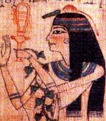
![]()
sistrum - An instrument consisting of a metal frame which loosely holds a number of metal rods, which jingle when shaken. Peculiarly Egyptian, it was used especially in the worship of Isis and is still used in Nubia.
site - In architecture, aspects of the place where a building will be constructed which might include: soil, climate, and neighborhood conditions, including zoning restrictions, along with the availability of water, food, transportation, energy, jobs, schools, churches, shopping, entertainment, etc. It may also refer to a specific place in any kind of environment.
Quote:
Also see earth art, environment art, plan, and site-specific.
site-specific - See installation.
Siva - See Shiva.
Six Dynasties - A Chinese dynastic period which lasted 220 - 589. During this time there were the Southern Dynasties, 317 - 589, and the Northern Dynasties, 386 - 581.

![]()
16-bit image - A digital image with sixteen bits allocated for the storage of each pixel, meaning 32,768 different colors are possible. An example is GraphicConverter's palette (color look-up table [CLUT]) of 32,768 different colors.
Also see Also see 1-bit image, 2-bit image, 3-bit image, 4-bit image, 8-bit image, 12-bit image, 24-bit image, 32-bit image, gradation and value scale.
size - Any of several gooey substances usually made from glue (the best is made from rabbit skin), wax, or clay, and used as a glaze or filler for porous materials such as paper, fabric, or wall surfaces, and used in sizing. Also, the physical dimensions, proportions, magnitude, or extent of an object. Size is one of the perspective tools an artist can use to create an illusion of depth on a two-dimensional surface, in that the nearer an object is the larger it appears to be, and the farther it is the smaller it appears to be.
Quote:
Also see circumference, colossus and colossal, Cyclopean, depth, diameter, direction, filter, full-scale, height, human scale, iconometer, length, measure, monumental, nail, optical illusion, radius, scale, sizes of common nails, sizes of finishing nails, visual scale, weight, and width.
sizing - Treatment of a fabric or other surface with size — any of several gooey substances usually made from glue (the best is made from rabbit skin), wax, or clay and used as a glaze or filler for porous material such as paper, cloth, or wall surfaces. Sizing prepares the surface of a support for priming and painting.
Also see papier-mâché.
sketch - A quick drawing that loosely captures the appearance or action of a place or situation. Sketches are often done in preparation for larger, more detailed works of art. Lion by Peter Paul Rubens (Flemish, 1577-1640) was done in preparation for his painting of Daniel in the Lions' Den. A sculptural sketch too is a quickly or loosely produced sculpture, typically made in working out ideas which the sculptor might later execute with more detail or in more expensive or more time-demanding materials.
Examples of sketches:

Giovanni Battista Tiepolo (Italian, Venetian,
1696-1770), Allegory of the Planets and Continents,
sketch, 1752, oil on canvas,
73 x 54 7/8 inches (185.4 x 139.4 cm), Metropolitan Museum of
Art, NY. (On the Met's page, you can enlarge any detail.)
Quote:
The Oxford English Dictionary says a hurrygraph is a "jocular nonce-word" meaning hurried sketch.
Also see abbozzo, blocking in, conté crayon, diagram, esquisse, fusain, gesture drawing, maquette, pochade, and study.
skyed -
Quote:
![]()
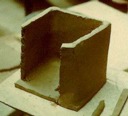
![]()
slab construction - A pottery technique in which a form is built up by joining shapes cut from thick sheets of damp clay.
Also see coil construction, scoring, pinch, potter's wheel, and slip.
slate - A metamorphic rock that splits into thin layers, most commonly used for roofing and writing surfaces, but sometimes for sculpture. May also refer to the medium-gray to black color of this rock.
Examples:

Dame Barbara Hepworth (English, 1903-1975),
Two Figures (Menhirs), 1964, slate,
82.5 x 63.8 x 32.0 cm, Tate Gallery, London. Hepworth's first
slate sculptures were carved from the bed of an old billiards
table. This modern sculpture takes the form
of stylized menhirs. See
English art.

Richard Long (English, 1945-), South Bank Circle, 1991, delabole slate, 10.0 x 199.7 x 199.7 cm, Tate
Gallery, London. Long made this circular
arrangement on a floor using
slate rocks he'd collected while on a long walk. See earth art.
Other resources concerning slate:
slide - An image on a transparent film, usually photographic, held in an opaque frame, and generally intended to be seen by an audience by projection of white light through it onto a large white screen.
An example:![]()
![]()
![]()
A slide showing the locations often recommended
for labeling information on them.
The first slides were called "magic lantern slides."
Examples:
English, Manufactured by Newton and Co., London, 1850-56, Crank magic lantern slide: Ship at Sea, wood, glass, and metal slide, 4 x 8 7/8 x 5/8 inches, Getty Research Institute, Werner Nekes Collection, Malibu, CA. This is and the following object are among 22 in the Devices of Wonder exhibit catalogued online by the Getty Museum — best seen with Flash and RealAudio plugins.
English, Manufactured by Carpenter and Westley, London, about 1880, Chromatrope: Artificial Fireworks, wood and glass chromatrope, 3 3/4 x 9 7/8 x 1/4 inches, Getty Research Institute, Malibu, CA. A hybrid magic lantern slide, a chromatrope (a made-up term using the ancient Greek words for "turning colors") could project large moving patterns of colors, somewhat like what is seen through a kaleidoscope.
Painter Max Weber took an art history slide lecture as the subject of this picture:

Max Weber (American, born Russia, 1881-1961),
Slide Lecture at the Metropolitan Museum,
1916, pastel
on paper, 24
1/2 x 18 3/4 inches (62.2 x 47.5 cm), Metropolitan Museum of
Art, NY.
Related resources:
Also see art history, copyright, magic lantern, reproduction, zoetrope, and zoopraxiscope.
slide scanner - A scanner with a slot in which to insert 35-mm slides; usually capable of scanning only 35-mm transparent material.
slip - An opaque, creamy liquid made by mixing finely ground clay with water. Slip is an inevitable byproduct of working on a potter's wheel, its name having resulted from potters' use of water to keep the spinning clay slippery as it's worked. It is also used in the making of pottery to cement together parts that have been formed separately; in slip casting, and in decorating surfaces.
Colored slips — also called engobes — have several distinctive attributes, but are also excellent alternatives to glazes because they are less expensive and less time consuming. They are typically made by mixing water with a claybody in use, then mixing in one or more colorants (e.g. oxides) — in a proportion of dry ingredients to water that is about 1:2 by volume. Colored slips are best applied in a consistency like cream to leatherhard greenware, or a little thinner when applied to bisque. Colored slips stay put — they won't run or blur as many glazes do. Textures made in slip will remain as they're formed, instead of smoothing out as do those made with glazes. They can be applied with a brush, a slip-trailing bottle, or by dipping or spraying. Another method for using slip in making a design is called sgraffito: coat unfired clay with a colored slip, and then scratch away at parts of it to reveal the clay surface underneath.
Also see ceramics, gesso, scoring, and stucco.
![]()

![]() slip
casting - Slush casting
by pouring slip into a plaster
mold, and then leaving
it until a thick skin forms inside the mold. The excess slip is
poured out and the hollow cast
left to harden. It was introduced into many European porcelain factories in the eighteenth century,
and was commonly employed for the casting of terra
cotta sculpture in the
nineteenth century.
slip
casting - Slush casting
by pouring slip into a plaster
mold, and then leaving
it until a thick skin forms inside the mold. The excess slip is
poured out and the hollow cast
left to harden. It was introduced into many European porcelain factories in the eighteenth century,
and was commonly employed for the casting of terra
cotta sculpture in the
nineteenth century.
slipstone - A small abrasive stone used to sharpen the inside curve or angle of a gouge or V-tool.
![]()

![]() slip-trailing - A method of creating a linear
design on a greenware
or bisque ceramic
body by applying slip (engobes)
to the clay by squeezing (extruding) it from a plastic
bottle fitted with a small opening in a pointed tip. The slip
should be mixed to a consistency approximately like heavy cream
(in a proportion of dry ingredients
to water that is about 1:2 by volume).
slip-trailing - A method of creating a linear
design on a greenware
or bisque ceramic
body by applying slip (engobes)
to the clay by squeezing (extruding) it from a plastic
bottle fitted with a small opening in a pointed tip. The slip
should be mixed to a consistency approximately like heavy cream
(in a proportion of dry ingredients
to water that is about 1:2 by volume).
slump mold - A type of drape mold, which see.
slurry - A mixture of plastic clay and water, useful in ceramics in many of the ways that slip is.
slush casting - A method of hollow casting in which a liquid or molten substance is hardened against the walls of a cold mold, generally with the aim of making a cast with very thin walls. The mold is rocked and rolled to insure that all of the smallest spaces are reached, and the walls are more or less even. Excess material is often poured out. Chocolate is regularly cast into bunnies and other shapes in this way. The indirect cast wax model in lost-wax casting is cast in this way in a plaster mold which has first been moistened. Plaster can itself be slush cast. Slip casting is a type of slush casting.
Also see release agent.
smalt - A particular blue pigment.
Related resource:
smalto - The colored glass or enamel used in mosaic.
smith - A person who works with metal, especially while it is hot and malleable, as when forging or casting it.
Also see metallurgy.
![]()

![]()
smock - A loose, shirtlike garment which protects the clothes of an artist. Smocks usually hang below the waste. Alternatives to smocks are aprons — covering only the front — and overalls — loose fitting pants with an extension that covers the chest.
Also see costume, easel, solvent, stain, stain removal, and studio.
snake - Any of many scaly, legless, sometimes venomous reptiles having long, tapering cylindrical and serpentine form. In Judeo-Christian iconography, snakes have often been employed as symbols of evil, as in the biblical representation of Satan as a snake tempting Adam and Eve, in images of the Virgin Mary standing on a snake to signify victory over sin, and of St. George slaying the Dragon. In even earlier traditions, snakes were often phallic symbols, sometimes signifying fertility, wisdom, or the power to heal. Consider the role played by snakes in the medical symbol called the caduceus, replacing hair on the head of Medusa, and in the Hellenistic sculpture of Laocoon. The Latin word for snake is draco, a bit of linguistic heritage to which J.K. Rowling connects Harry Potter's most unpleasant schoolmate at Hogwarts.
Examples:
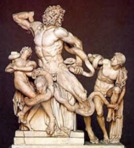
Laocoön and his Sons, Roman copy of a Hellenistic
original from c. 200 BCE,
marble, height
1.84 m, Vatican. Trojan priest Laocoön and his two sons
are attacked at an altar
by giant snakes. Pliny said it was the work of three sculptors
from Rhodes, Hagesandros, Polydoros, and Athenodoros. The date
of the Laocoon is controversial, some scholars arguing
for the late second century BCE,
others for c. 50 BCE.
See pain and Roman art.

Guatemala,
Maya peoples, Vase with Snake Design, 8th century -
9th century, earthenware,
height 6 1/8 inches, Minneapolis
Institute of Arts.

Aztec/Mixtec (Mexico), Double-Headed Serpent,
15th - 16th century, mosaic of turquoise, iron pyrites and shell on carved wood, traces of gilding, British Museum, London. The serpent was perhaps the single most important animal in Aztec religion. Because it sheds its skin, it was linked with renewal and transformation. The serpent is associated with several Aztec gods including Quetzalcoatl (Feathered Serpent), Xiuhcoatl (Fire Serpent), Mixcoatl (Cloud Serpent) and Coatlicue (She of the Serpent Skirt), the mother of the main Aztec god Huitzilopochtli. It is also connected with human sacrifice and a double-headed serpent design is engraved on the sacrificial stone at the Great Temple in Tenochtitlan. See ancipital, Mesoamerican art, and Pre-Columbian art.
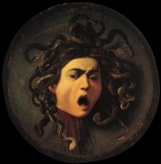
Caravaggio (Italian, 1573-1610), Medusa, oil
on a circular convex
leather shield, diameter
55.5 cm, Uffizi Gallery, Florence. See Baroque, Caravaggisti,
and mythology.
![]()
Rembrandt van Rijn (Dutch, 1606-1669), Nude Woman with a Snake, about 1637,
red chalk heightened
with white body color, 9
11/16 x 5 7/16 inches (24.7 x 13.7 cm), J. Paul Getty Museum,
Malibu, CA. See Baroque
and drawing.

Sri Lankan, The Serpent Demon, a Kolam dancer's mask, 19th century,
pre-1885, height 66 cm, British
Museum, London. Sri Lanka is the island once known as Ceylon
to the east of India. Kolam is a rural Sri Lankan form of drama
involving both mime, dialogue, and dance,
by actors who wear masks and costumes. The museum says, "The
characters are divided into several types: humans (for example,
princes, the drummer and his wife, the European), animals and
demons, and the performances move from the depiction of village
scenes to stories involving spirits and fabulous creatures from Hindu mythology. The Serpent Demon is a fierce
character representing the evil power of snake poisons that can
destroy human and animal life. The figure
can be recognized partly by the presence of the cobras coiling
to form a crown around its
head and the snakes that emerge from its nostrils. There are
several species of poisonous snakes in Sri Lanka; the cobra in
particular is often depicted on demon masks that are used by
dancers in rituals to expel evil from the body of a patient."

American Indian, Cuahilla Mission, California,
Snake
and Mouse Design Basket, c. early 20th century, Millicent
Rogers Museum, Taos, NM. See basket.
Quote:
In ceramics, a "snake" is a rope-like piece of clay with which a coil pot is constructed.
Also see coil, Madonna and meander, and Pre-Columbian art.
https://inform.quest/_art